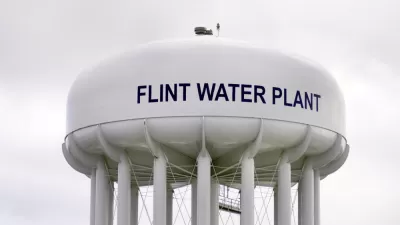There's good but guarded news on drinking water. Lead levels are lower, below the federal action threshold, but residents are advised not to drink it without using filters. A federal state of emergency in effect since January was lifted Sunday.

Researchers from Virginia Tech with Flint residents conducted 162 random sampling of drinking water obtained from Flint homes in July. Their findings for lead, Legionella, water heater study, and disinfection by-products were released August 11.
Good news!
"The 90th percentile level for lead was 13.9 ppb," reports Rebecca Williams, environment reporter for Michigan Radio, an NPR member station. "This is below the EPA action level of 15 ppb."
“Things are dramatically better now,” said Marc Edwards, the Virginia Tech environmental engineering professor who played a key role in bringing the lead crisis to the nation's attention last year.
By comparison, sampling in August, 2015 showed 28.7 ppb and results in March, 2016 were 22.5 ppb. [See slide 13, page 13/47.]
"This is nearing the end of the beginning of the end of the public health disaster response," said Edwards, a MacArthur Foundation fellow. "Flint water now looks like it’s entering a range that’s considered normal for other U.S. cities."
But before you drink the water....
"Kelsey Pieper, a postdoctoral fellow at Virginia Tech, said their sampling pool is a random sample of homes and does not specifically target the highest risk homes for lead," adds Williams. "So, while their results show the homes they tested are below the action level, it’s not an official result that would qualify under the EPA’s Lead and Copper Rule."
"Residents certainly should continue using bottled water and filters until notification from the Environmental Protection Agency or the state — no one is saying the water is safe," added Edwards in the Virginia Tech News.
End of federal state of emergency
"With the end of the emergency, the state will now be responsible for all the costs associated with getting clean water to Flint citizens and running the city's eight community stations (the federal government covered 75 percent of the costs, and the state was responsible for 25 percent during the January to August Federal State of Emergency)," reports the Detroit Metro Times. President Barack Obama had declared a state of emergency on January 16 in response to a request by Gov. Rick Snyder.
Roots of crisis
The lead crisis began when the state-appointed emergency manager for the city of 102,000, 57 percent African American, made the fateful decision in April 2014 by going off the Detroit drinking water system, which draws from Lake Huron and switch to the Flint River to save money, without adding an anti-corrosive ingredient. See Michigan Radio's timeline on the crisis beginning July 2011.
After switching back to Lake Huron water last October, Flint took the first step to alleviating the crisis by 'coating the pipes' with the "chemical phosphates that were missing from the water between April 2014 and October 2015, because of mistakes by the Michigan Department of Environmental Quality(MDEQ) and City of Flint," notes the January 30 post.
The lack of corrosion controls allowed corrosive Flint River water to carry away lead from pipes, joints and fixtures. Over time, Gov. Rick Snyder said, the phosphates will build up a protective coating between the pipes and the water they carry, making them capable of delivering safe drinking water.
Ongoing investigation
In April, two state officials in MDEQ and a Flint water plant administrator were criminally charged in the lead crisis. On July 29, six additional state employees were charged, reports CNN. "The allegations show a concerted effort to cover up warning signs of lead poisoning, according to prosecutors."
Lead pipe replacement?
"Many buildings and homes still have lead pipes, which health officials say need to be replaced, but that will take time," reports PBS. “It might very well, across the country, take 100 years before we get all the lead plumbing out,” said Edwards.
FULL STORY: Virginia Tech's latest Flint water tests: not safe to drink, but getting better

Depopulation Patterns Get Weird
A recent ranking of “declining” cities heavily features some of the most expensive cities in the country — including New York City and a half-dozen in the San Francisco Bay Area.

California Exodus: Population Drops Below 39 Million
Never mind the 40 million that demographers predicted the Golden State would reach by 2018. The state's population dipped below 39 million to 38.965 million last July, according to Census data released in March, the lowest since 2015.

Chicago to Turn High-Rise Offices into Housing
Four commercial buildings in the Chicago Loop have been approved for redevelopment into housing in a bid to revitalize the city’s downtown post-pandemic.

Twin Cities Trains Move to Fewer Cars, Higher Frequency
Headways will drop from 15 minutes to 12 minutes.

DC Bikeshare System Breaks Ridership Record
Capital Bikeshare users took over 20,000 rides on one day in March.

EV Infrastructure Booming in Suburbs, Cities Lag Behind
A lack of access to charging infrastructure is holding back EV adoption in many US cities.
Barrett Planning Group LLC
City of Cleburne
KTUA Planning and Landscape Architecture
HUD's Office of Policy Development and Research
Mpact Transit + Community
HUD's Office of Policy Development and Research
City of Universal City TX
ULI Northwest Arkansas
City of Laramie, Wyoming
Urban Design for Planners 1: Software Tools
This six-course series explores essential urban design concepts using open source software and equips planners with the tools they need to participate fully in the urban design process.
Planning for Universal Design
Learn the tools for implementing Universal Design in planning regulations.




















